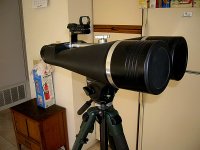JabaliHunter
Well-known member
First of all, let me apologise if one of my earlier threads offended anyone's sensibilities. It was not my intention and I'll tread more carefully in future.
I joined this site to learn more about binoculars, specifically models suitable for low light wildlife viewing.
I feel that my current pair of 10yr old Swarovski 10x42 ELs are not quite right for me. I think it is because of the 4.2mm exit pupil, but also the relatively narrow field of view. Yes I can see the shakes in the 10x too, but am usually able to support them if necessary. I don't know if I either need to drop magnification or go bigger on the front end, or both.
I will certainly try the Zeiss 8x56 T*FL. It has a wider field of view, bigger exit pupil and lower magnification, so ticks all the boxes above. I note Henry Link’s extensive review of the benefits of large objective and long focal length binoculars too. But it is pretty much the same weight as carrying around a full bottle of wine!
The Leica 8x50 HD would also give a large exit pupil and lower magnification, but no wider field of view than my 10x42. I am not technically astute enough to know whether similar large objective/long focal length benefits would also be achieved with this model. I suspect that for the latter, the focal length is not long enough...
A 5-5.25mm exit pupil seems fairly ubiquitous and I could achieve that with a wide field of view in say an 8x42 Zeiss FL, Leica HD or 8.5x42 Swarovski EL; or in a 10x50 EL with a narrower field of view (same as a 10x42EL). I suppose only trial and error will tell me if I prefer a larger exit pupil or not.
It has also been suggested to me that the colour bias of different binocular models may have more of an effect than increasing exit pupil size above 5mm, something I haven't looked into yet!
I will admit to feeling a bit lost in choosing an appropriate pair of binoculars. I have been talking to various shops but they are not much help. Nowhere that I can find seems to have the models that I want to see in the same place. But they all helpfully point out that I won't be disappointed with whatever I choose!
Any advice, comment or observation welcome.
Thanks in advance.
I joined this site to learn more about binoculars, specifically models suitable for low light wildlife viewing.
I feel that my current pair of 10yr old Swarovski 10x42 ELs are not quite right for me. I think it is because of the 4.2mm exit pupil, but also the relatively narrow field of view. Yes I can see the shakes in the 10x too, but am usually able to support them if necessary. I don't know if I either need to drop magnification or go bigger on the front end, or both.
I will certainly try the Zeiss 8x56 T*FL. It has a wider field of view, bigger exit pupil and lower magnification, so ticks all the boxes above. I note Henry Link’s extensive review of the benefits of large objective and long focal length binoculars too. But it is pretty much the same weight as carrying around a full bottle of wine!
The Leica 8x50 HD would also give a large exit pupil and lower magnification, but no wider field of view than my 10x42. I am not technically astute enough to know whether similar large objective/long focal length benefits would also be achieved with this model. I suspect that for the latter, the focal length is not long enough...
A 5-5.25mm exit pupil seems fairly ubiquitous and I could achieve that with a wide field of view in say an 8x42 Zeiss FL, Leica HD or 8.5x42 Swarovski EL; or in a 10x50 EL with a narrower field of view (same as a 10x42EL). I suppose only trial and error will tell me if I prefer a larger exit pupil or not.
It has also been suggested to me that the colour bias of different binocular models may have more of an effect than increasing exit pupil size above 5mm, something I haven't looked into yet!
I will admit to feeling a bit lost in choosing an appropriate pair of binoculars. I have been talking to various shops but they are not much help. Nowhere that I can find seems to have the models that I want to see in the same place. But they all helpfully point out that I won't be disappointed with whatever I choose!
Any advice, comment or observation welcome.
Thanks in advance.





